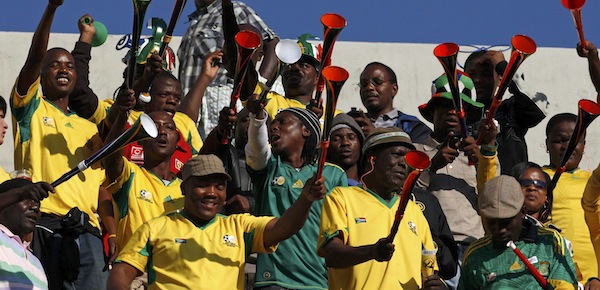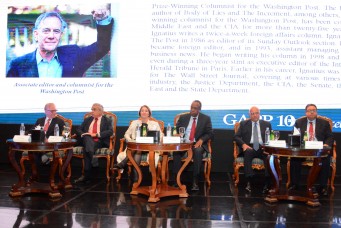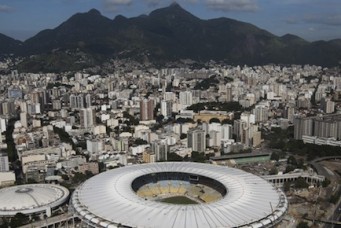How to Host a World Cup
South African officials claimed that the 2010 football tournament would strengthen national cohesion and bolster the economy. There’s scant evidence that it did either.

South African football fans during a World Cup match between Paraguay and New Zealand, Peter Mokaba Stadium, Polokwane, June 24, 2010. Ivan Alvarado/Reuters/Corbis
We have been witnessing a change in the geography of international sport. Increasingly, nations from the developing world are competing to stage sporting mega-events, such as the Olympic Games and the finals of the Fédération Internationale de Football Association, or FIFA World Cup.
Beijing’s 2008 Olympic Games inaugurated the new era. In 2010, South Africa hosted the FIFA World Cup and New Delhi was the venue for the Commonwealth Games. Now it is Brazil’s turn, as the South American nation hosts the world’s two premier sporting events back to back, the FIFA World Cup this year, and the Olympic Games, to be held in Rio de Janeiro in 2016. Countries from the former Communist bloc are part of the trend, as evidenced by Russia’s hosting of the Winter Olympic Games this year and the FIFA finals in 2018, and by Ukraine and Poland co-hosting the 2012 Euro football finals. Even the tiny state of Qatar is getting into the act, having won the bid to mount the FIFA World Cup in 2022.
To grasp this sporting shift to the Global South and East, consider the Olympic Games, for instance. In its near 120-year modern history, the Games have been staged in Asia only twice prior to the 2008 Games in Beijing: Tokyo hosted the 1964 Olympics and Seoul the 1988 Games. Mexico’s 1968 Summer Olympics marks the only time that the Games have been held in Latin America—Brazil’s hosting this year is a first for the continent of South America. Thus far, there has been only one African contender for the Olympics, when the South African city of Cape Town was shortlisted by the International Olympic Committee for the 2004 Games; the bid from Athens eventually succeeded.
Growing competition among industrializing states to host mega-events reflects, on one hand, dynamics in the world economy and in the international sport sector specifically, and on the other, greater awareness about the business potential of sport. The sporting corporate landscape has significantly expanded over the years and now includes major firms spanning the fields of media and branding, broadcast, event organizing, and apparel manufacturing. Mega-events draw corporations from these fields together, and attract those from ancillary economic sectors, such as construction, transport, accommodation, and tourism. Given this, mega-events are considered platforms for the generation of capital. These kinds of events have become highly commoditized and commercialized. They are mediatized or framed in certain ways by corporations and sporting federations to heighten their popular as well as commercial allure.
Thus there is usually a strong economic narrative that underpins and rationalizes government campaigns to host mega-events. This narrative stresses the catalytic potentials: their ability to attract foreign investments; to spark domestic investment in neglected or underdeveloped areas; to boost overall economic growth; and finally, to help position a country more favorably in a competitive international environment through the construction of a particular nation brand.
It is also typical that for hosts in the Global South there are other motives beyond economic ambitions in the staging of sporting mega-events. This has to do with the kinds of states that they are and their place in the international arena. These countries that successfully canvas to host sporting mega-events share a number of features: although not fully industrialized they display rapid levels of growth and related social change. Their status as middle-income countries means that they have an expansive and growing middle class, although they are often highly stratified societies, and the pace of their advance is often associated with greater income inequalities. Many of these states are home to large deposits of valued primary resources that enable commodity-driven export growth. This, coupled with swift economic change, gives them substantial and growing influence over trajectories in the world economy.
However, their political influence often fails to match their economic influence. Although many may be powerful actors in their immediate regional sphere (Brazil in South America, South Africa in Africa, India in South Asia, and so on), and may be viewed as leaders in the developing world, they usually lack the political leverage of the major states of the Global North (in particular the United States)—at least not in the domains of international politics associated with hard power (i.e., political authority and influence over the main pillars of world power backed up by strategic military capacities). In such circumstances, hosting sporting mega-events is often used as an instrument of soft power and as a means to gain greater influence and prominence in the world system.
There are also domestic elements that constitute important subsidiary motives in staging mega-events. More often than not, the societal make-up of these countries is highly heterogeneous as far as their ethnic, racial, and class composition is concerned, which can be sources for societal tensions and outright conflict. The nature of the relationship between the state—or governing authority—and society is frequently fragile, and the legitimacy of the state or dominant political classes is often questioned or challenged. New Delhi’s hosting of the 2010 Commonwealth Games, for example, occurred in a context of vulnerability of the Indian state towards domestic insurgencies. A significant part of the Brazilian authorities’ preparations for the 2014 FIFA World Cup and the 2016 Olympic Games, furthermore, centers on neutralizing domestic challenges to the government’s sovereignty emanating from organized and ‘disorganized’ crime, the latter mostly located in the country’s infamous favelas.
In such settings the staging of mega-events takes on a dual function: to highlight to the international community the capacities of the state—to underscore the state’s sovereignty and prowess—and to reinforce the idea of the state to its own domestic audiences. Mega-events are often linked to national ideologies of modernization and are viewed by governments as vehicles to achieve comprehensive national transformation.
Viva, South Africa, Viva!
These elements were all at play in South Africa’s bid for and build up to the 2010 FIFA World Cup. Though the FIFA World Cup was, because of its magnitude, the most important sporting event ever hosted by South Africa, it was by no means the first time that the country staged a major sporting tournament.
Indeed the trend over the past two decades has therefore been for South Africa to bid for both first- and second-order events and to successfully host some key gatherings. It is not only in the sporting domain where this has been the case. The country has also hosted large United Nations meetings in the past.
The sporting events have been of particular strategic significance for the country because it enables the attainment of both international and domestic objectives. South Africa’s successful hosting of the 1995 Rugby World Cup—capped by its remarkable victory in the tournament—is perhaps most illustrative in this regard. It signaled simultaneously the country’s re-entry into the international domain, its organizational capacities, certain achievements as far as economic development was concerned, and crucially, a semblance of racial unity. The latter was memorably captured when then President Nelson Mandela appeared on the pitch following the host country’s victory wearing the green and yellow Springbok jersey bearing the number of team captain Francois Pienaar. Throughout the liberation struggle, the Springbok jersey was considered by many as an emblem of apartheid’s racism; hence Mandela’s celebration with the mostly white team signaled a new era of national reconciliation in which all population groups should participate in the construction of a unified and prosperous South Africa poised to assume its place in the international community.
Indeed, South Africa’s engagement with sporting mega-events demonstrates the point that they are of instrumental value for political actors because of the audiences they reach and the way in which they do this. Events such as the Olympics and the FIFA World Cup are successful partly because of how they are staged as media festivals, but mostly because they are spectacles that capture the popular imagination and are on a scale greater than anything we encounter in our everyday lives. The triumph and political symbolism of the 1995 Rugby World Cup—portrayed in the 2009 film Invictus starring Morgan Freeman and Matt Damon—set the tone for how South Africa’s political authorities have viewed sporting mega-events over the last two decades; as instruments to achieve larger goals.
Against this backdrop, South Africa’s bid for the 2010 FIFA World Cup reflected to a significant degree the meshing of sport, politics, diplomatic ambition, and domestic developmental objectives. When Mandela’s successor as president, Thabo Mbeki, made the country’s final submission to FIFA in Zurich in June 2004, he characterized the bid as “an African journey of hope,” and linked it to major political tasks such as democratic consolidation and the advancement of South Africa and wider Africa’s populations.
Specific objectives for the FIFA World Cup were articulated in a range of documentation by the Local Organizing Committee (LOC) and later, the South African government. The LOC set out to use the tournament “to strengthen the African and South African image, [to] promote new partnerships with the world as we stage a unique and memorable event… [and to] be significant global players in all fields of human endeavor.” The national government placed emphasis on socio-economic development, the country’s image, and its ties with the rest of the African continent. For the government, the World Cup was an opportunity “to speed up development and growth in the country so that it leaves behind a proud legacy that will benefit generations of South Africans to come.”
Since the intention was to create benefit for the wider African continent, a couple of years before the tournament took place, it was rebranded the “African World Cup,” and its official slogan became “Ke Nako (It’s Time) Celebrate Africa’s Humanity.” An official Africa Legacy Programme was developed with several objectives, namely to “support the realization of African renaissance”; to ensure that all African countries participated in the event; to further the development of African football; and to improve the international image of the continent. Therefore the ambitions for the World Cup were lofty and much was anticipated in terms of the tournament’s potential symbolic, political, and economic legacies.
Costs Versus Benefits
In a context where so much is wagered politically on a sporting event, what are the costs, gains, and long-term impacts they could have? The case of South Africa is instructive. There were a number of significant challenges that the country’s authorities and planners faced during the tournament’s planning and preparation phases that cast into doubt whether the myriad expectations would be met. The first concerned the very critical question of whether South Africa had the required infrastructural, physical, and human resource capacity. In the years leading to the tournament, there was much skepticism in the international community over South Africa’s chances of successfully hosting the tournament and completing all preparations on time; on the potential effects of crime; and the possibility that political instability may jeopardize the event. There was some speculation that the event would be moved to another location.
Such skepticism was not fully unwarranted. In preparation for the World Cup, much emphasis was placed on the timely development of three types of infrastructure: the competition venues/stadiums; transportation; and tourist accommodation. Of the ten stadiums that were used for matches, six were newly built or refurbished, while four existing stadiums—used in the past mostly for rugby—were upgraded. All of the stadiums were completed on time, but this was often accompanied by excessive cost escalation and persistent allegations of corruption around tendering processes. The development of road and other transport infrastructure that was undertaken as part of the tournament—many host cities have used the World Cup as an opportunity to develop new urban commuter networks—also saw delays and increases in costs. Before the event, it was not certain whether the country’s tourist facilities would be sufficient to accommodate the expected overseas visitor flow.
The possibility that the tournament could be marred by social unrest constituted a second cluster of challenges. A growing tide of civic action questioned the real social benefit of hosting the World Cup and thereby threatened to derail the event. Authorities had to consider the potential repercussions for the country’s image as well as long-term political fallout from a failed tournament.
As such, the question of whether the World Cup could spark national pride and be the basis for social cohesion became all the more important. There were concerted efforts to re-create the euphoria and sense of national unity that came in the wake of South Africa’s victory in the 1995 Rugby World Cup. For instance, national promotion and loyalty campaigns led by the public sector—national and host city governments—tried to popularize the World Cup in the months before the tournament. Certain days of the week were declared national football days (“Football Fridays”). On these days, citizens were encouraged to wear the colors of the national football team, known as Bafana Bafana, and to brandish World Cup paraphernalia. Programs were held at schools to raise awareness of the event among youths. During the tournament itself, there was a noteworthy level of domestic support for the national and even other African football teams. The tribal horn known as the vuvuzela—reviled by foreign teams and fans but very popular among South Africans from all racial and class backgrounds—became a symbol of an ascendant and harmonious South Africa, another expression of the metaphoric “Rainbow Nation.”
From the perspective of the government, the World Cup successfully achieved the historical mission towards racial harmony. The incumbent president, Jacob Zuma, heralded the event as “one of post-apartheid South Africa’s greatest achievements,” and noted that “the wearing of Bafana Bafana jerseys and the display of the rainbow flag everywhere in our country by patriotic South Africans will forever be part of our heritage… [these national colors] unite us and strengthen solidarity.”
Yet, the durability or even authenticity of these expressions of unity, and what they mean in a country where racial divisions persist, are unclear. A critical view advanced by some of the country’s prominent civil society leaders and intellectuals sees the World Cup celebrations as a short-lived moment of “fake nationhood” without real substance or indications of real societal transformation. It is noteworthy that in the years since the tournament South Africa has been plagued by record levels of civil unrest and labor strikes related to demands for service delivery and higher wages. These protests have, worryingly, sometimes been met with violent responses by the police, as witnessed by the widely publicized killing of scores of striking miners at a platinum facility in late 2012. All this suggests a low sense of national cohesion, with race, along with class, constituting major factors of division. Indeed, expectations before the FIFA tournament that it could recreate the euphoria of the 1995 Rugby World Cup never seemed to have materialized.
The economic benefits of the tournament are also subject to question. Without a doubt, the 2010 FIFA World Cup was the largest spending occasion in South Africa’s modern history, with significant volumes of public and private capital mobilized. According to official sources, national authorities spent around $3 billion on the construction and upgrade of stadiums and event-related infrastructure. A further $1.7 billion was spent on policing, marketing, and on the opening and closing ceremonies. A few years before the tournament, the national government also launched a major infrastructure development program, which though linked to the World Cup, was meant to spearhead broad-based development. This program saw around $85 billion spent on the upgrade of ports, roads, railways, and energy sources. When one considers that the spending of capital on a range of hard and soft infrastructure was done not only by the national government, but also provincial and city governments, as well as local rural municipalities, and included private investments in a variety of sectors, the total cost of spending for the tournament is inestimable. Hence, it is important to ask what kinds of return the event has achieved, and whether the initial rationalizations used during the bid stage, in particular arguments concerning the event’s potential economic and employment benefits, have been justified.
Soon after the tournament drew to a close, it was clear that the event was a success as far as FIFA’s ambitions were concerned; that is, as a global media event and in terms of revenue created for the international sporting federation. The 2010 World Cup generated television receipts of $2.4 billion and total revenue of $3.6 billion, making it the most profitable FIFA finals so far.
Tourist arrivals for the World Cup, however, also considered a proxy for the success of the tournament, were one-third lower than predicted, and tourist receipts were about 20 percent below what was predicted. Thus, while the event had clear economic benefits for FIFA, the gains for South Africa’s economy were less apparent. In the short term, economic sectors such as construction benefited from lucrative tenders related to infrastructure development for the event. However, independent studies show that this does not seem to have led to widespread or permanent employment in that sector, nor does it appear that other economic sectors saw notable rises in employment or growth.
Instead, on measures of GDP output over the past five years, South Africa’s economy first contracted—it was in recession for the whole of 2009—and mustered fragile recovery with growth of 2-3 percent since the World Cup hosting. The major reason for this pattern is the impact of the global economic crisis, which South Africa primarily weathered through the export of mining commodities. This performance appears sclerotic when compared to the economic growth rates of other emerging powers. More significant is the fact that the South African economy shed around one million jobs during the recession, which it only partially recovered thereafter. The country’s official unemployment rate has remained at an unsustainable level of around 25 percent and has even marginally increased over the past two years. It would seem that rather than reversing South Africa’s fortunes, as was promised prior to the tournament, the World Cup had a negligible impact on the basic structure of the South African economy.
It is not surprising that competing narratives have arisen around the issue of the mega-event’s long-term benefits and costs. One narrative, advanced by the national government, persistently emphasizes the World Cup’s significance for the country’s agenda of socio-economic transformation. Another, looser narrative, arising from the ranks of civil society, questions the distributional benefits and possible debt implications. There have been striking similarities between South Africa’s FIFA World Cup experience and Brazil’s preparations for the 2014 finals. No doubt, Brazilians, too, will eventually find themselves debating the value of hosting mega-events.
Scarlett Cornelissen is a professor of political science at Stellenbosch University, where she teaches international relations. She is co-editor of Africa and International Relations in the 21st Century and Sport Past and Present in South Africa: (Trans)forming the Nation.
Subscribe to Our Newsletter





